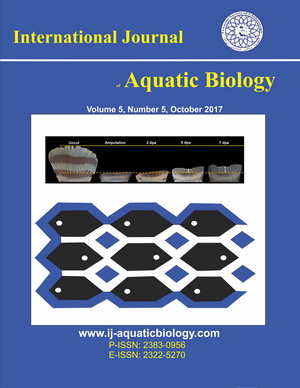Occurrence, characterization, and hazard assessment of microplastics in edible tissues of commercial fishes from public wet markets in Cebu Province, Philippines
Downloads
This study examined the occurrence, characterization, and hazard risk of microplastics (MPs) in the edible tissues of commercial fish from public wet markets in Cebu Province, Philippines. Fish samples from eleven species were collected from eight municipalities (Argao, Bogo City, Carcar City, Daanbantayan, Liloan, Naga City, Oslob, and Toledo City) and analyzed for microplastics using microscopy and ATR-FTIR. Three hundred eighty-nine MP particles were identified, with benthic fish (N = 197) showing a slightly higher count than pelagic fish (N = 192). Argao had the highest MP count (N = 60), while Daanbantayan had the lowest. Euthynnus affinis had the highest MP concentration (19%, N = 74), followed by Scarus psittacus and Cypselurus opisthopus (16%, N = 64 each). Of the samples, 30% were confirmed as microplastics, revealing 15 distinct polymer types, including polyvinyl alcohol (PVA) (20%), polyacetylene (PA) (17%), and polyvinyl chloride (PVC) (7%). The polymer hazard index (PHI) indicated that polyethylene (PE) and polyethylene terephthalate (PET) posed a "High" risk, while acrylonitrile-butadiene-styrene (ABS), PVC, and polyurethane (PU) were classified under "Extreme Danger". These findings suggest that local agricultural practices, laundry activities, and waste disposal contribute to MP contamination in fish tissues, warranting further investigation into the health implications of MP consumption.
Downloads
Lomboy C.A., Garces J.J. (2020). Abundance and characteristics of microplastics in commercially sold fishes from Cebu Island, Philippines. International Journal of Aquatic Biology, 8(6): 424-33.
Alabi O.A., Ologbonjaye K.I., Awosolu O., Alalade O.E. (2019). Public and environmental health effects of plastic wastes disposal: A review. Journal of Toxicology and Risk Assessment, 5: 021.
An L., Liu Q., Deng Y., Wu W., Gao Y., Ling W. (2020). Sources of microplastic in the environment. Microplastics in terrestrial environments: Emerging contaminants and major challenges. In: Microplastics in Terrestrial Environments. pp: 143-59.
Bansal O.P., Singh A. (2022). A review on microplastic in the soils and their impact on soil microbes, crops and humans. International Journal of Research, 10: 245-73.
Bouzekry A., Mghili B., Bouadil O., Mancuso M., Ben-Haddad M., Bottari T., Bottari T., Aksissou M. (2023). First Report of Microplastic Ingestion in Edible Fish along Moroccan Mediterranean Coasts. Sustainability, 15(23): 16313.
Cole M., Lindeque P., Halsband C., Galloway T.S. (2011). Microplastics as contaminants in the marine environment: a review. Marine Pollution Bulletin, 62(12): 2588-97.
Courtene?Jones W., Clark N.J., Fischer A.C., Smith N.S., Thompson R.C. (2022). Ingestion of microplastics by marine animals. Plastics and the Ocean: Origin, Characterization, Fate, and Impacts, 20: 349-66.
Cowger W., Gray A., Christiansen S.H., DeFrond H., Deshpande A.D., Hemabessiere L., Lee E., Mill L., Munno K., Ossmann B.E., Pittroff M. (2020). Critical review of processing and classification techniques for images and spectra in microplastic research. Applied Spectroscopy, 74(9): 989-1010.
Dantas N.C., Duarte O.S., Ferreira W.C., Ayala A.P., Rezende C.F., Feitosa C.V. (2020). Plastic intake does not depend on fish eating habits: Identification of microplastics in the stomach contents of fish on an urban beach in Brazil. Marine Pollution Bulletin, 153: 110959.
Di Giacinto F., Di Renzo L., Mascilongo G., Notarstefano V., Gioacchini G., Giorgini E., Bogdanovi? T., Petri?evi? S., Listeš E., Brklja?a M., Conti F. (2023). Detection of microplastics, polymers and additives in edible muscle of swordfish (Xiphias gladius) and bluefin tuna (Thunnus thynnus) caught in the Mediterranean Sea. Journal of Sea Research, 192: 102359.
DOST-PCIEERD. (2022). PlastiCount Pilipinas: Counting and Visualizing Marine Plastics Pollution in the Philippines.
Galloway T.S., Cole M., Lewis C. (2017). Interactions of microplastic debris throughout the marine ecosystem. Nature Ecology and Evolution, 1(5): 0116.
Galafassi S., Campanale C., Massarelli C., Uricchio V.F., Volta P. (2021). Do freshwater fish eat microplastics? A review with a focus on effects on fish health and predictive traits of MPs ingestion. Water, 13(16): 2214.
Gavigan J., Kefela T., Macadam-Somer I., Suh S., Geyer R. (2020). Synthetic microfiber emissions to land rival those to waterbodies and are growing. PLoS One, 15(9): e0237839.
Geolin K.R.C., Villegas L.M.G., Alburo R.P. (2021). Metallothionein response of aninikad, Canarium labiatum (Roding, 1798) to heavy metal concentrations in Balamban coastline, Cebu. Journal of Agriculture and Technology Management (JATM), 24(1): 1-12.
Gorme J.B., Maniquiz M.C., Song P., Kim L.H. (2010). The water quality of the Pasig River in the City of Manila, Philippines: Current status, management and future recovery. Environmental Engineering Research, 15(3): 173-9.
Gündo?du S., Cevik C., Ata? N.T. (2022). Occurrence of microplastics in the gastrointestinal tracts of some edible fish species along the Turkish coast. Turkish Journal of Zoology, 44(4): 312-23.
Jambeck J.R., Geyer R., Wilcox C., Siegler T.R., Perryman M., Andrady A., Narayan R., Law K.L. (2015). Plastic waste inputs from land into the ocean. Science, 347(6223): 68-71.
Jin S.G. (2022). Production and application of biomaterials based on polyvinyl alcohol (PVA) as wound dressing. Chemistry–An Asian Journal, 17(21): e202200595.
Karami A., Golieskardi A., Choo C.K., Romano N., Ho Y.B., Salamatinia B. (2017). A high-performance protocol for extraction of microplastics in fish. Science of the Total Environment, 578: 485-94.
Karrman A., Schonlau C., Engwall M. (2016). Exposure and effects of microplastics on wildlife: A review of existing data. Orebro Universitet, Orebro. 39 p.
Keerthika K., Padmavathy P., Rani V., Jeyashakila R., Aanand S., Kutty R., Tamilselvan R., Subash P. (2023). Microplastics accumulation in pelagic and benthic species along the Thoothukudi coast, South Tamil Nadu, India. Marine Pollution Bulletin, 189: 114735.
Makhdoumi P., Hossini H., Nazmara Z., Mansouri K., Pirsaheb M. (2021). Occurrence and exposure analysis of microplastic in the gut and muscle tissue of riverine fish in Kermanshah province of Iran. Marine Pollution Bulletin, 173: 112915.
Muhdhar M.H., Sumberartha I.W., Hassan Z., Rahmansyah M.S., Tamalene M.N. (2021). Examination of microplastic particles in reef fish food in Ternate Island waters, Indonesia. Jordan Journal of Biological Sciences, 14(4): 853-8.
Lithner D., Larsson Å., Dave G. (2011). Environmental and health hazard ranking and assessment of plastic polymers based on chemical composition. Science of the Total Environment, 409(18): 3309-24.
National Oceanic and Atmospheric Administration (NOAA). (2015). What are microplastics? National Ocean Service Website, http://oceanservice.noaa.gov/ facts/microplastics.html
Nithin A., Sundaramanickam A., Iswarya P., Babu OG. (2022). Hazard index of microplastics contamination in various fishes collected off Parangipettai, Southeast coast of India. Chemosphere, 307: 136037.
Osorio E.D., Tanchuling M.A., Diola M.B. (2021). Microplastics occurrence in surface waters and sediments in five river mouths of Manila Bay. Frontiers in Environmental Science, 9: 719274.
Palermo J.D., Labrador K.L., Follante J.D., Agmata A.B., Pante M.J., Rollon R.N., David L.T. (2020). Susceptibility of Sardinella lemuru to emerging marine microplastic pollution. Global Journal of Environmental Science and Management, 6(3): 373-84.
Park T.J., Lee S.H., Lee M.S., Lee J.K., Lee S.H., Zoh K.D. (2020). Occurrence of microplastics in the Han River and riverine fish in South Korea. Science of the Total Environment, 708: 134535.
Ranjani M., Veerasingam S., Venkatachalapathy R., Mugilarasan M., Bagaev A., Mukhanov V., Vethamony P.J. (2021). Assessment of potential ecological risk of microplastics in the coastal sediments of India: a meta-analysis. Marine Pollution Bulletin, 163: 111969.
Saha M., Naik A., Desai A., Nanajkar M., Rathore C., Kumar M., Gupta P. (2021). Microplastics in seafood as an emerging threat to marine environment: a case study in Goa, west coast of India. Chemosphere, 270: 129359.
Sy?Changco J.A., Pornpitakpan C., Singh R., Bonilla C.M. (2011). Managerial insights into sachet marketing strategies and popularity in the Philippines. Asia Pacific Journal of Marketing and Logistics, 23(5): 755-72.
Wik A., Dave G. (2009). Occurrence and effects of tire wear particles in the environment–A critical review and an initial risk assessment. Environmental Pollution, 157(1): 1-1.
World Bank Group. (2021). Market study for the Philippines: Plastics Circularity Opportunities and Barriers.https://www.worldbank.org/en/country/philippines/publication.
Zhang K., Gong W., Lv J., Xiong X., Wu C. (2015). Accumulation of floating microplastics behind the Three Gorges Dam. Environmental Pollution, 204: 117-23.
Zitouni N., Bousserrhine N., Belbekhouche S., Missawi O., Alphonse V., Boughatass I., Banni M. (2020). First report on the presence of small microplastics (? 3 ?m) in tissue of the commercial fish Serranus scriba (Linnaeus. 1758) from Tunisian coasts and associated cellular alterations. Environmental Pollution, 263: 114576.
Copyright (c) 2024 International Journal of Aquatic Biology

This work is licensed under a Creative Commons Attribution 4.0 International License.








